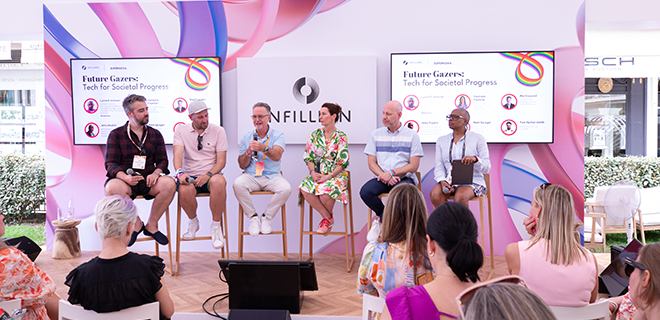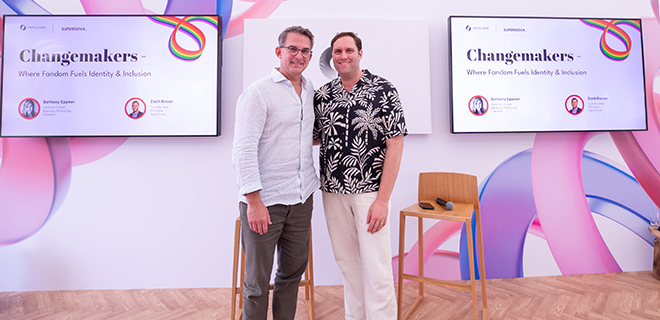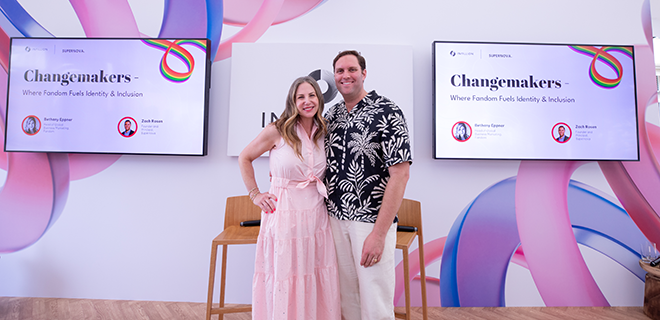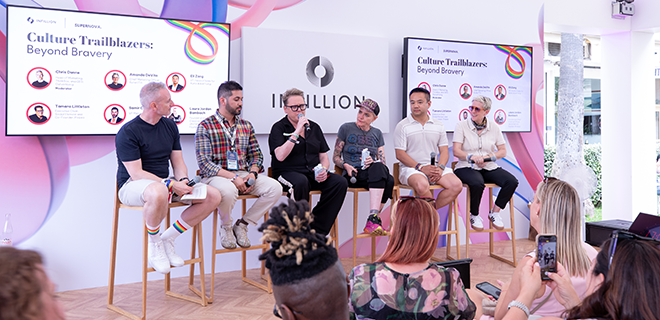
Inclusive Innovation at Cannes? Supernova PRIDE Brought the Receipts
At Supernova PRIDE, industry leaders turned the Cannes conversation on its head. From travel media to fandom to AI ethics, here are eight takeaways that prove inclusive innovation is good for culture—and business.
Photos by Whitnee Shulman
In a year where rainbow logos were scarce, the Supernova PRIDE Summit brought substance, clarity, and ambition. With sessions on AI, identity, fandom, commerce, and brave leadership, this first-of-its-kind gathering during Cannes Lions 2025 drew a roadmap for action.
At Cannes Lions this year, the Pride season was much quieter.
The Croisette, once a parade of rainbow logos and branded beach takeovers, pulled back under the weight of political pressure and industry hesitance. But in the packed Infillion Café, outside the Mondrian Hotel, a different kind of energy came through loud and clear.
Supernova PRIDE, founded by Zach Rosen, re-centered the conversation on leadership, accountability, and infrastructure. The Summit brought together CMOs, strategists, and technologists to tackle the urgent question: What does inclusive innovation look like—and who is building it?
Sessions tackled a range of topics, from algorithmic bias, airport media, and psychological safety as a business driver.
The Summit also had a tangible impact. Ten percent of sponsorship proceeds went directly to Hue, SAGE, and the Transgender Law Center. “At the end of the day, when we talk about believing in change here, we’re not just going to believe it. We’re going to fund it,” Michelle Lea Kim, Vice President, West Coast at Ogury, said.
Here are eight key takeaways that illustrate how inclusion gets operationalized.
Eight Ways Supernova PRIDE Put Inclusive Leadership Into Practice
1. Inclusive marketing drives performance. Period.
Brands that invest in reaching underrepresented audiences see measurable business results. “Half of P&G’s brand growth over the last three years came from re-including excluded audiences,” Phil Cowdell, Global Chief Strategy Officer, Channel Factory, said, citing CMO Marc Pritchard. The growth didn’t come from shiny new products or clever packaging, but from showing up authentically for consumers.
2. AI without transparency is just bias at scale.
“Generative AI doesn’t do anything without data,” said Matt Spiegel, EVP of Growth, TransUnion Marketing Solutions. But, of course, not all data is created equal, and several panelists warned against handing the keys to black-box systems.
For data to support equity and not undermine it, human intervention is necessary. And that’s at every layer—from design to deployment. “Bias shows up in the prompt, the dataset, and the user. Check all three,” Phil Cowdell, Global Chief Strategy Officer, Channel Factory, said.
3. Commerce media needs more inclusive infrastructure.
As retail and travel brands build out performance media networks, inclusion can’t be an afterthought. It needs to show up in the content, data, and partnerships from day one. “Representation starts with what’s on the screen,” Aaron Gallagher, Managing Director, Head of Sales, Kinective Media by United Airlines, said.
4. Measurement needs to move beyond impressions.
Thinking that travelers are just audiences is a mistake. They’re high-intent consumers with shifting needs throughout the journey. “We measure every second of the traveler experience,” Gallagher said. That means building measurement into the infrastructure—from the jet bridge to the jetway—and optimizing for moments of relevance, not just reach.
5. Queer fandoms are a cultural and commercial force.
Platforms that understand how people define themselves offer brands a more powerful, authentic way to connect. For instance, Gen Z doesn’t identify by demographic; they identify by passion. “They don’t want to be marketed to,” she said. “They want to be part of the conversation,” Bethany Eppner, VP of Global Business Marketing, Fandom, said.
With 19 million LGBTQ+ users engaging with entertainment and gaming content every month, the message to brands stands clear: Show up where queer joy lives.
6. Community metrics are the next frontier in brand measurement.
Traditional metrics like impressions and reach don’t tell you how your message lands. What matters is how deeply audiences connect with the content and whether they feel seen in the storytelling. That’s why brands and platforms are rethinking what success looks like.
It’s about tapping into the moments where fandom becomes identity. That’s why Fandom is moving beyond surface-level metrics to track emotional drivers like “joy, celebration, discovery, and representation,” according to Eppner.
But first, brands need to earn trust. “You can’t fake inclusion. Audiences know when they’re being pandered to,” Rosen said.
7. Psychological safety drives innovation and resilience.
Real inclusion happens when people feel safe to speak up, push back, and challenge leadership. That’s when the best ideas surface—and when brands are most prepared for the unexpected. “When there is real psychological safety,” Tamara Littleton, Executive Chair, Social Element and Co-Founder at Polpeo, said. “People challenge authority. They speak up. And the work gets better.”
From client meetings to crisis response, Inclusive cultures not only feel better, they perform better.
8. Brave leadership is a practice, not a personality.
Companies need structures—like inclusive hiring practices, accountability frameworks, and clear values—to turn intentions into outcomes. “Brave leadership isn’t a personality trait. It’s a competency,” Amanda DeVito, Chief Marketing Officer of Butler/Till, said.
Across the panel, leaders shared stories of speaking up, protecting team members, and operationalizing inclusion through values, hiring practices, and KPIs. While many companies treat DEI as a mission statement, meaningful change only happens when leaders are strategic about inclusion.
The Real Work Is Year-Round
“Some great organizations and leaders are already championing change and visibility,” Rosen said. “But we can’t go at this alone. This isn’t just about one summit at Cannes—it’s about showing up at every tentpole event, every boardroom, every opportunity where queer leadership and inclusive innovation belong.”
Pride doesn’t end in June. Real impact means showing up all year—with funding, strategy, infrastructure, and accountability. We’ve got the receipts. Now, let’s build the blueprint.


